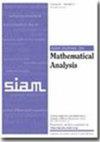系数变化的声波传输问题的骨架积分方程
IF 1.9
2区 数学
Q1 MATHEMATICS, APPLIED
引用次数: 0
摘要
SIAM 数学分析期刊》,第 56 卷,第 5 期,第 6232-6267 页,2024 年 10 月。 摘要在本文中,我们将推导一个非局部("积分")方程,它将一个具有可变系数、非零吸收和混合边界条件的三维声波传输问题转化为域[math]的 "骨架 "上的一个非局部方程,其中 "骨架 "代表[math]的一个 Lipschitz 分区的界面和边界的联合。为此,我们将抽象层势引入并分析为辅助强制全空间变分问题的解,并推导出跨域界面的跳跃条件。这样,我们就能将非局部骨架方程表述为原始偏微分方程解的未知考奇数据的直接方法。我们基于辅助全空间变分问题,建立了骨架方程变分形式的矫顽力和连续性。不需要格林函数的明确表达式,而且我们所有的估计值在复波数中都是明确的。本文章由计算机程序翻译,如有差异,请以英文原文为准。
Skeleton Integral Equations for Acoustic Transmission Problems with Varying Coefficients
SIAM Journal on Mathematical Analysis, Volume 56, Issue 5, Page 6232-6267, October 2024.
Abstract. In this paper we will derive a nonlocal (“integral”) equation which transforms a three-dimensional acoustic transmission problem with variable coefficients, nonzero absorption, and mixed boundary conditions to a nonlocal equation on a “skeleton” of the domain [math], where “skeleton” stands for the union of the interfaces and boundaries of a Lipschitz partition of [math]. To that end, we introduce and analyze abstract layer potentials as solutions of auxiliary coercive full space variational problems and derive jump conditions across domain interfaces. This allows us to formulate the nonlocal skeleton equation as a direct method for the unknown Cauchy data of the solution of the original partial differential equation. We establish coercivity and continuity of the variational form of the skeleton equation based on auxiliary full space variational problems. Explicit expressions for Green’s functions is not required and all our estimates are explicit in the complex wave number.
Abstract. In this paper we will derive a nonlocal (“integral”) equation which transforms a three-dimensional acoustic transmission problem with variable coefficients, nonzero absorption, and mixed boundary conditions to a nonlocal equation on a “skeleton” of the domain [math], where “skeleton” stands for the union of the interfaces and boundaries of a Lipschitz partition of [math]. To that end, we introduce and analyze abstract layer potentials as solutions of auxiliary coercive full space variational problems and derive jump conditions across domain interfaces. This allows us to formulate the nonlocal skeleton equation as a direct method for the unknown Cauchy data of the solution of the original partial differential equation. We establish coercivity and continuity of the variational form of the skeleton equation based on auxiliary full space variational problems. Explicit expressions for Green’s functions is not required and all our estimates are explicit in the complex wave number.
求助全文
通过发布文献求助,成功后即可免费获取论文全文。
去求助
来源期刊
CiteScore
3.30
自引率
5.00%
发文量
175
审稿时长
12 months
期刊介绍:
SIAM Journal on Mathematical Analysis (SIMA) features research articles of the highest quality employing innovative analytical techniques to treat problems in the natural sciences. Every paper has content that is primarily analytical and that employs mathematical methods in such areas as partial differential equations, the calculus of variations, functional analysis, approximation theory, harmonic or wavelet analysis, or dynamical systems. Additionally, every paper relates to a model for natural phenomena in such areas as fluid mechanics, materials science, quantum mechanics, biology, mathematical physics, or to the computational analysis of such phenomena.
Submission of a manuscript to a SIAM journal is representation by the author that the manuscript has not been published or submitted simultaneously for publication elsewhere.
Typical papers for SIMA do not exceed 35 journal pages. Substantial deviations from this page limit require that the referees, editor, and editor-in-chief be convinced that the increased length is both required by the subject matter and justified by the quality of the paper.

 求助内容:
求助内容: 应助结果提醒方式:
应助结果提醒方式:


